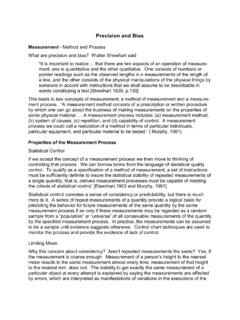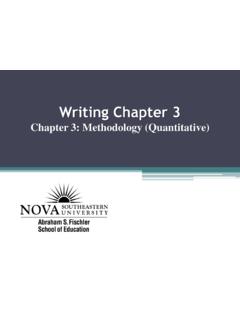Transcription of Chapter 1: Physical Quantities, Units and Measurements
1 General Physics Physical Quantities & Units AS level Marline Kurishingal Quantitative Observations What can be measured with the instruments on an aeroplane? Qualitative Observations How do you measure artistic beauty? Physical Quantities Quantitative versus qualitative Most observation in physics are quantitative Descriptive observations (or qualitative) are usually imprecise Physical Quantities A Physical quantity is one that can be measured and consists of a magnitude and unit. SI Units are used in Scientific works Measuring length 70 km/h m Are classified into two types: Base quantities Derived quantities Physical Quantities Base quantity For example : is like the brick the basic building block of a house Derived quantity For example : is like the house that was build up from a collection of bricks (basic quantity) Definitions :- Base quantities are the quantities on the basis of which other quantities are expressed.
2 The quantities that are expressed in terms of base quantities are called derived quantities SI Units for Base Quantity Base Quantities Name of Unit Symbol of Unit length metre m mass kilogram kg time second s electric current ampere A temperature kelvin K amount of substance mole mol SI Units International System of Units 9 Derived quantity & equations A derived quantity has an equation which links to other quantities. It enables us to express a derived unit in terms of base-unit equivalent. Example: F = ma ; Newton = kg m s-2 P = F/A ; Pascal = kg m s-2/m2 = kg m-1 s-2 10 Some derived Units Derived quantity Base equivalent Units _____ Symbol area square meter m volume cubic meter m speed, velocity meter per second m/s or m s-1 acceleration meter per second squared m/s/s or m s-2 density kilogram per cubic meter kg m-3 amount concentration mole per cubic meter mol m-3 force kg m s-2 Newton work/energy kg m2 s-2 Joule power kg m2 s-3 Watt pressure kg m-1 s-2 Pascal frequency s-1 Hertz SI Units 1.
3 Equation: area = length width In terms of base Units : Units of area = m m = m2 2. Equation: volume = length width height In terms of base Units : Units of volume = m m m = m3 3. Equation: density = mass volume In terms of base Units : Units of density = kg m 3 SI Units Work out the derived quantities for: 1. Equation: speed = In terms of base Units : Units of speed = ms 1 2. Equation: acceleration = In terms of base Units : Units of acceleration = ms 2 3. Equation: force = mass acceleration In terms of base Units : Units of force = kg ms-2 timedistancetimevelocitySI Units Work out the derived quantities for: 1. Equation: Pressure = In terms of base Units : Units of pressure = Kgm 1 s 2 2.
4 Equation: Work = Force Displacement In terms of base Units : Units of work = Kgm s 2 3. Equation: Power = In terms of Units : Units of power = Ar eaFor ceTimedoneWor k Kgm s 3 Derived Quantity Relation with Base and Derived Quantities Unit Special Name Momentum Electric Charge Potential Difference Resistance SI Units Fill For you to Reference Link Physical quantities 1. A Physical quantity is a quantity that can be measured and consists of a numerical magnitude and a unit. 2. The Physical quantities can be classified into base quantities and derived quantities. 3. There are seven base quantities: length, mass, time, current, temperature, amount of substance and luminous intensity. 4. The SI Units for length, mass, time, temperature and amount of substance, electric current are metre, kilogram, second, kelvin, mole and ampere respectively.
5 Homogeneity of an equation An equation is homogeneous if quantities on BOTH sides of the equation has the same unit. s = ut + at2 LHS : unit of s = m RHS : unit of ut = ms-1xs = m unit of at2 = ms-2xs2 = m Unit on LHS = unit on RHS Hence equation is homogeneous Non-homogeneous P = gh2 LHS ; unit of P = Nm-2 = kgm-1s-2 RHS : unit of gh2 = kgm-3(ms-2)(m2) = kgs-2 Unit on LHS = unit on RHS Hence equation is not homogeneous Note: numbers has no unit some constants have no unit. , A homogeneous eqn may not be physically correct but a physically correct eqn is definitely homogeneous s = 2ut + at2 (homogenous but not correct) F = ma (homogeneous and correct) Homogeneity of an equation Magnitude Prefix : magnitudes of Physical quantity range from very large to very small.
6 Mass of sun is 1030 kg and mass of electron is 10-31 kg. Hence, prefix is used to describe these magnitudes. Significant number Magnitudes of Physical quantities are often quoted in terms of significant number. Can you tell how many sig. fig. in these numbers? 103, , , , 200 If you multiply and , how many sf should you quote? , , , , The rules for identifying significant figures The rules for identifying significant figures when writing or interpreting numbers are as follows:- All non-zero digits are considered significant. For example, 91 has two significant figures (9 and 1), while has five significant figures (1, 2, 3, 4 and 5). Zeros appearing anywhere between two non-zero digits are significant.
7 Example: has seven significant figures: 1, 0, 1, 1, 2, 0 and 3. Leading zeros are not significant. For example, has two significant figures: 5 and 2. The rules for identifying significant figures (cont) Trailing zeros in a number containing a decimal point are significant. For example, has six significant figures: 1, 2, 2, 3, 0 and 0. The number still has only six significant figures (the zeros before the 1 are not significant). In addition, has five significant figures since it has three trailing zeros. Often you will be asked to estimate some magnitudes of Physical quantities around you. estimate the height of the ceiling, volume of an apple, mass of an apple, diameter of a strand of hair, Reference link : Estimates of Physical quantities When making an estimate, it is only reasonable to give the figure to 1 or at most 2 significant figures since an estimate is not very precise.
8 Occasionally, students are asked to estimate the area under a graph. The usual method of counting squares within the enclosed area is used. Physical Quantity Reasonable Estimate Mass of 3 cans (330 ml) of Pepsi 1 kg Mass of a medium-sized car 1000 kg Length of a football field 100 m Reaction time of a young man s Convention for labelling tables and graphs t/s v/ms 1 0 The symbol / unit is indicated at the italics as indicated in the data column left. Then fill in the data with pure numbers. Then plot the graph after labelling x axis and y axis [Illustration with sample graph on left] Prefixes For very large or very small numbers, we can use standard prefixes with the base Units . The main prefixes that you need to know are shown in the table.
9 (next slide) Prefixes Prefixes simplify the writing of very large or very small quantities Prefix Abbreviation Power nano n 10 9 micro 10 6 milli m 10 3 centi c 10 2 deci d 10 1 kilo k 103 mega M 106 giga G 109 Tera ? ?? Prefixes Alternative writing method Using standard form N 10n where 1 N < 10 and n is an integer This galaxy is about 106 light years from the Earth. The diameter of this atom is about 1 10 10 m. Scalars and Vectors Scalar quantities are quantities that have magnitude only. Two examples are shown below: Measuring Mass Measuring Temperature Scalars and Vectors Scalar quantities are added or subtracted by using simple arithmetic. Example: 4 kg plus 6 kg gives the answer 10 kg + = 4 kg 6 kg 10 kg Scalars and Vectors Vector quantities are quantities that have both magnitude and direction Magnitude = 100 N Direction = Left A Force Scalars and Vectors Examples of scalars and vectors Scalars Vectors distance displacement speed velocity mass weight time acceleration pressure force energy momentum volume density Direction of vector Scalars and Vectors Adding/Subtracting Vectors using Graphical Method Parallel vectors can be added arithmetically 2 N 4 N 6 N 4 N 2 N 2 N Scalars and Vectors Adding Vectors using Graphical Method Non-parallel vectors are added by graphical means using the parallelogram law Vectors can be represented graphically by arrows The length of
10 The arrow represents the magnitude of the vector The direction of the arrow represents the direction of the vector The magnitude and direction of the resultant vector can be found using an accurate scale drawing cm N Direction = right Vector addition Vector operation Vector problem must be solved vectorically unlike scalar quantity. 3 N + 4 N = 5 N 3N 4 N 5 N Addition using drawing method Reference link : Vector addition if D = A B Subtraction using drawing method The parallelogram law of vector addition states that if two vectors acting at a point are represented by the sides of a parallelogram drawn from that point, their resultant is represented by the diagonal which passes through that point of the parallelogram Scalars and Vectors 44 Coplanar vectors When 3 or more vectors need to be added, the same principles apply, provided the vectors are all on the same plane coplanar To subtract 2 vectors, reverse the direction change the sign of the vector to be subtracted, and add 45 Change in a Vector Case 1 If an object changes it's direction but not speed.












